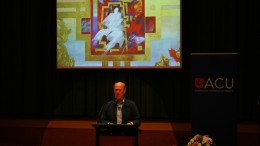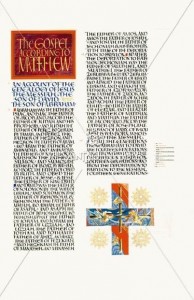“Illumination turns up the volume on a page,” declared Donald Jackson, world-renowned calligrapher and Senior Illuminator to Queen Elizabeth II.
He was speaking in Sydney at a public lecture on the making of The Saint John’s Bible – said to be the first handwritten, hand-illuminated Bible since the advent of the printing press. The $4 million dollar, 15 year project was commissioned in 1998 by Saint John’s (Abbey and University) in Minnesota, USA. Saint John’s says it hoped that as people explored the contemporary work celebrating ancient techniques, “the Scriptures would open up to them and… become a journey toward God.”
So what exactly is an illuminated Bible, and how is it different from an illustrated one? Canberra-based historian and Bible translator Dr John Harris explains, “An illuminated Bible has decorative letters and pages; it may have some illustrated pages but the decoration of the letters makes it an illuminated text.”
Those who attended the lecture could see first hand how the craft accentuated text on a page. Two facsimiles of the seven-volume manuscript were on display.
Jackson developed the calligraphy used in The Saint John’s Bible, experimenting with different styles before settling on a “Romanesque form, but one which has its own little squirms.” Five other calligraphers worked on the manuscript with him, which meant that there was room for individual influence, despite working to a plan. “It was like conducting an orchestra. There was quite a lot of chance in it, which I like.”
Collaborating with a team of scholars, theologians, calligraphers and illuminators, Jackson used a mixture of techniques to create the Bible. This included text handwritten with goose and turkey quills on calf-skin vellum, as well as the use of gold and platinum leaf, hand-ground pigments and Chinese stick ink.
“One of the calligraphers found the quill desperately uncomfortable. It results in variations, and is a completely tactile thing. But the imperfection of a quill is a better conduit… it’s not about surface perfection, it’s about capturing the emotion.”
Seventy-five year old Jackson has always loved calligraphy. “When you make a mark, and it’s good, you feel good. So, it feeds you!”
When Jackson described himself as “not a full-on religious person, though steeped in Judeo-Christian culture” Eternity asked if working on the Bible had impacted his understanding of its content and truth. “You can’t not be” he affirmed. “You have to dig and dig deeper into yourself as you work on this.”
He quoted the text from Isaiah 6:8, Here I am! Send me. “I first had a mental picture of those words, about coal touching unclean lips. I illustrated it several times, but in the end I just wrote the words out. I realised the words themselves were more powerful than any picture. And then, after doing that, I asked myself… where do I stand?”
Perhaps that introspection best supports the claim that The Saint John’s Bible is “a major artistic, cultural, and spiritual endeavour.” Its true worth is measured not so much by its cost or scale of production, but in that the illuminated Bible “turns up the volume” for all who read its ancient text.
The Australian Catholic University, which organised the Sydney lecture, will soon have a complete set of facsimiles, which may later be made available for exhibition in Australia.
Some information and photos sourced from saintjohnsbible.org
- Psalm 38
- The genealogy in Matthew 1
- Donald Jackson explaining the different techniques used to create The Saint John’s Bible
- Illuminated text of Matthew 1
Email This Story
Why not send this to a friend?










